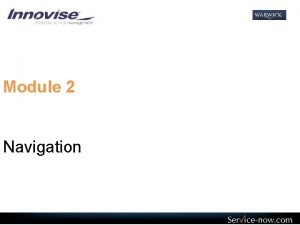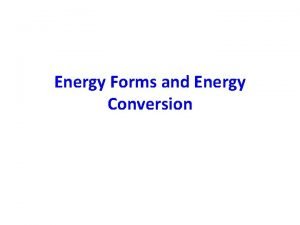Energy Forms 1 Question Research Task SLIDE NAVIGATION






- Slides: 6

Energy Forms 1. Question & Research Task SLIDE NAVIGATION 1 2 3 4 5 6 We use energy to move our bodies. Energy is all around us at all times. We even use energy when we sit still. Energy is the ability to do work or make change. It is what we use to make things happen! Let’s build some background knowledge about the different forms of energy: • Click or tap on the Brain. Pop icon on the BCPS Digital Content page. • Then, return to this slide and select the picture on the right to view the Brain. Pop video, Forms of Energy. Image Source: Brain Pop Keep these questions in mind as you research the different forms of energy: • What are the different forms of energy? • How and when is energy used? • How does energy change from one form to another? In this Slam Dunk, you will conduct brief, focused research to respond to the inquiry question: How are different forms of energy used? Next

2. Information Sources SLIDE NAVIGATION 1 2 3 4 5 6 Next Energy moves in different ways… Heat, sound, light, electricity, and motion are all ways that energy moves. Your own voice carries energy that moves on sound waves. Sunlight carries energy that plants use to make food. Image Source: Wikimedia Commons 1. Read Energy is Everywhere, a Wonders article assigned by your teacher in BCPS One. 2. Use these Information Sources to continue researching each of the different energy forms.

3. Student Activity SLIDE NAVIGATION 1 2 3 4 As you research forms of energy using the sources on Slide 2, look for information that helps you to answer these questions: • • • What are some sources of this form of energy? • What are some technologies that use this form of energy? • What technologies are used to find or extract this form of energy? How is this energy used? What are the advantages and disadvantages on the environment of using this form of energy? Organize your thoughts and ideas on the Forms of Energy web or foldable organizer. • NOTE: The foldable organizer will need to be printed out. Image Source: Fashions-clouds. net 5 6 Next

4. Assessment Activity SLIDE NAVIGATION 1 2 3 How are different forms of energy used? Now it’s time to show what you know! Choose one of the following products to share your new knowledge with your classmates: Trading Card Voki (Tutorial) Discovery Ed Board (Tutorial) Be sure to reference the rubric to ensure that you have included the necessary information. Image Source: Eand. EManagement. com 4 5 6 Next

5. Enrichment Activities SLIDE NAVIGATION 1 2 3 4 5 6 Renewable and Non-Renewable Resources Renewable energy can be used over and over. • sunlight • wind • moving water • heat beneath the ground • energy from plants Non-renewable energy sources cannot be “recycled” and can run out. • coal, oil, and natural gas Visit these sources to learn more … Image Source: Research. Gate. net • • • Energy and the Environment Renewable and Non-Renewable Energy Resources Energy Sources (Brain. Pop video) • Click or tap on the Brain. Pop icon here, then return to this slide to open the link. Image Source: Research. Gate. net Next

6. Teacher Resources Learning Standards Alignment Next Generation Science Standards NGSS 4 PS 3 -2 Make observations to provide evidence that energy can be transferred from place to place by sound light, heat, and electric currents. 4 -ESS 3 -1 - Science and Engineering Principle (SEP) “Obtain and combine information from books and other reliable media to explain phenomena. “ Common Core State Standards for English Language Arts & Literacy Reading: 1. Read closely to determine what the text says explicitly and to make logical inferences from it; cite specific textual evidence when writing or speaking to support conclusions drawn from the text. Writing: 7. Conduct short as well as more sustained research projects based on focused questions, demonstrating understanding of the subject under investigation. AASL Standards Framework for Learners Inquire: Build new knowledge by inquiring, thinking critically, identifying problems, and developing strategies for solving problems. Think: Learners display curiosity and initiative by: I. A. 2 Recalling prior and background knowledge as context for new meaning. Create: Learners engage with new knowledge by following a process that includes: I. B. 1 Using evidence to investigate questions. I. B. 3 Generating products that illustrate learning. Share: Learners adapt, communicate, and exchange learning products with others in a cycle that includes: I. C. 1 Interacting with content presented by others. Grow: Learners participate in an ongoing inquiry-based process by: I. D. 2 Engaging in sustained inquiry. P 21 Framework: 21 st Century Student Outcomes 3. Information, Media & Technology Skills: Information Literacy: Access information efficiently and effectively; Use information accurately and creatively for the issue or problem at hand. ICT Literacy: Use technology as a tool to research, organize, evaluate and communicate information. SLIDE NAVIGATION 1 2 3 4 5 6 Grade 4 Science: Energy Objective: Students will conduct brief, focused research in order to define and describe forms of energy and how they may affect the environment. Time Frame: 1 -2 class periods for research; 1 -2 class periods for product creation and jigsaw. Differentiation strategies for this lesson: • Have students use learning supports provided in any BCPS-licensed Digital Content included in this lesson. Refer to Digital Content Snapshots & Support resources for as needed. Notes to the teacher: • Collaborate with your school library media specialist to plan and implement this lesson. • This slam dunk could be implemented as a jigsaw in which each student researches only one form of energy, collaborates in an expert group, and then shares with groups who researched a different energy form. A synthesis chart is also provided for students to collect shared information from presentations ( such as a gallery walk of student products). • Student choice of organizer: Web or Foldable • Resources in World Book, Pebble Go, and the Wonders Anthology include a Read Aloud feature. Websites can be read aloud by copying and pasting the text to a Word document (add the “speak selected text” to the quick links toolbar) • Readings from the Wonders Anthology listed on the Information Sources page are included in the corresponding Lesson folder(s) in BCPS One. Teachers should assign these links on tiles in BCPS One for student access. Last updated: July 2019 Report broken links to BCPS Library Media Programs & Digital Resources 443 -809 -4035 BCPS Slam Dunk Research Model, Copyright 2018, Baltimore County Public Schools, MD, all rights reserved. This lesson may be used for educational, non-profit school use only. All other uses, transmissions, and duplications are prohibited unless permission is granted expressly. This lesson is based on Dr. Jamie Mc. Kenzie’s Slam Dunk Digital Lesson model.











